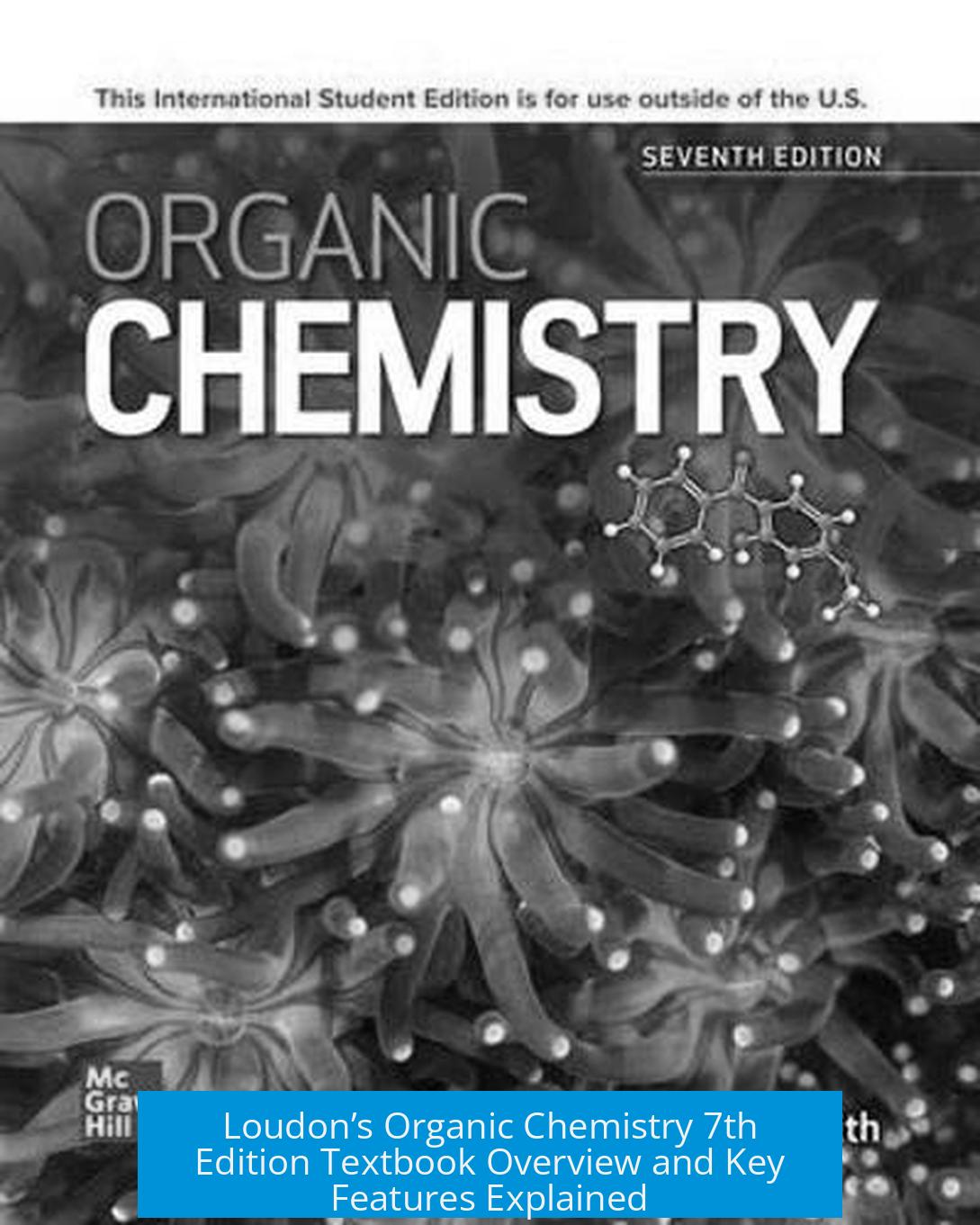Loudon’s Organic Chemistry 7th Edition Textbook Overview
Loudon’s Organic Chemistry 7th edition offers a clear, insightful presentation of organic chemistry, designed to build understanding rather than rote memorization. The textbook organizes complex concepts into accessible sections, augmented by informative illustrations and examples. Its content connects organic chemistry principles to everyday biological applications, helping students grasp and retain knowledge effectively.
This edition is suited for both classroom use and as a reference beyond college. The textbook’s structure and illustrative approach cater to learners by focusing on conceptual clarity and application.
Key Features of Loudon’s 7th Edition
- Engaging Presentation: The textbook fosters deep understanding over memorization by providing analogies and relatable biological contexts to complex organic chemistry topics.
- Comprehensive Problem Sets: Each chapter includes a wide range of problems aimed at reinforcing key concepts and developing problem-solving skills.
- Illustrations and Examples: Carefully selected visuals support the textual explanation, making abstract concepts more tangible.
- Long-Term Reference: Beyond the course, the book serves as a valuable resource for graduate studies or professional reference.
- E-book Access: Available with highlighting and note-taking tools for reading both online and offline, enhancing study flexibility.
- Achieve Platform: Integrated with the user-friendly Achieve platform that improves student engagement and learning outcomes.
Detailed Table of Contents and Subject Coverage
The textbook divides organic chemistry into 28 well-structured chapters. Each chapter addresses key topics sequentially to build foundational knowledge through to advanced concepts.
| Chapter No. | Topic | Overview |
|---|---|---|
| 1 | Chemical Bonding and Chemical Structure | Fundamental bonding theories and molecular structures that underpin organic molecules. |
| 2 | Alkanes and Organic Nomenclature | Naming conventions for organic compounds and the properties of alkanes. |
| 3 | The Curved-Arrow Notation, Resonance, Acids and Bases, and Chemical Equilibrium | Mechanism notation, electronic distribution, acid-base chemistry, and equilibrium concepts in organic reactions. |
| 4 | Introduction to Alkenes and Alkynes | Structure, bonding, and properties of unsaturated hydrocarbons. |
| 5 | Addition Reactions of Alkenes and Alkynes | Mechanisms and types of reactions adding atoms or groups to unsaturated molecules. |
| 6 | Principles of Stereochemistry | Study of spatial arrangements and their influence on chemical behavior. |
| 7 | Cyclic Compounds and Reaction Stereochemistry | Properties and stereochemical reactions of ring structures. |
| 8 | Nomenclature and Noncovalent Intermolecular Interactions | Complex naming and interactions like hydrogen bonding and van der Waals forces. |
| 9 | The Chemistry of Alkyl Halides: Substitution and Elimination Reactions | Reactions involving alkyl halides and mechanisms of substitution and elimination. |
| 10 | Free-Radical Reactions, Main-Group Organometallic Compounds, and Carbenes | Mechanisms and roles of free radicals and special reactive intermediates. |
| 11 | The Chemistry of Alcohols and Thiols; Ethers, Epoxides, Glycols, and Sulfides | Functional group properties, synthesis, and reactions of oxygen- and sulfur-containing compounds. |
| 13 | Introduction to Spectroscopy: Infrared Spectroscopy and Mass Spectrometry | Techniques for determining molecular structure and composition. |
| 14 | Nuclear Magnetic Resonance Spectroscopy | Advanced elucidation of molecular structures via NMR methodologies. |
| 15 | Dienes and Aromaticity | Properties and reactions of conjugated systems and aromatic compounds. |
| 16 | The Chemistry of Benzene and its Derivatives | Reactivity and substitution mechanisms in benzene and related compounds. |
| 19 | The Chemistry of Aldehydes and Ketones; Carbonyl-Addition Reactions | Functional group reactions and addition mechanisms involving carbonyl compounds. |
| 20 | The Chemistry of Carboxylic Acids | Structure, acidity, and derivatives of carboxylic acid compounds. |
| 22 | The Chemistry of Enolate Ions, Enols, and α,β-Unsaturated Carbonyl Compounds | Related intermediates and their roles in organic synthesis and reactivity. |
| 23 | The Chemistry of Amines | Properties and reactions of nitrogen-containing organic compounds. |
| 27 | Amino Acids, Peptides, and Proteins | Organic chemistry relevant to biomolecules foundational to life sciences. |
| 28 | Pericyclic Reactions | Mechanistic details of cycloaddition and rearrangement processes. |
E-Book and Digital Learning Tools
Loudon’s Organic Chemistry 7th edition features an e-book version tailored for active learning. Students can read online or offline and use digital highlighting or note-taking tools. These features support diverse study habits and increase information retention.
The textbook also integrates with the Achieve platform. This single, easy-to-use interface provides interactive assignments, auto-graded problems, and real-time feedback. It aims to improve student engagement profoundly and enhances course outcomes through adaptive learning techniques.
Educational Approach
Loudon stresses comprehension by connecting organic chemistry with practical applications. Analogies drawn from biology and everyday life make complex topics more understandable. This helps bridge academic chemistry to real-world situations.
Its reliance on a broad range of problems fosters critical thinking and reinforces learning. Problems vary in difficulty and type, accommodating new learners and more advanced students alike.
How Loudon’s Organic Chemistry 7th Ed Excels
- Clarity: Clear explanation of bonding, mechanism notation, and molecular interactions simplifies difficult concepts.
- Depth: Detailed coverage from fundamental to advanced topics supports a comprehensive learning journey.
- Relevance: Emphasizes real-world biological applications and uses up-to-date examples.
- Accessibility: Available digitally with annotation tools, supporting modern student needs.
- Engagement: The Achieve platform ensures interactive learning experiences with immediate feedback.
- Longevity: Designed as a resource beyond undergraduate courses, useful for reference and research.
Summary of Key Takeaways
- Loudon’s Organic Chemistry 7th edition prioritizes understanding over memorization through clear explanations and real-life analogies.
- The textbook features a comprehensive chapter layout covering foundational to advanced organic chemistry topics sequentially.
- Digital tools such as the e-book with note-taking and the Achieve platform enhance study flexibility and student engagement.
- Its educational framework links organic chemistry principles to biology and everyday contexts to deepen learning retention.
- Robust problem sets encourage skill development and critical thinking from basic to complex levels.
- Recommended for undergraduates and as a long-term professional reference.
What makes Loudon’s Organic Chemistry 7th ed textbook useful beyond college?
This textbook provides clear explanations and plenty of examples. It focuses on understanding concepts over memorizing facts. Its organization and illustrations help retain knowledge for future reference.
How does the e-book version enhance learning?
The e-book allows reading online or offline. It includes tools for highlighting and taking notes, which help in reviewing and organizing study material efficiently.
What topics are covered related to spectroscopy in the book?
Chapters 13 and 14 cover spectroscopy. These include infrared spectroscopy, mass spectrometry, and nuclear magnetic resonance spectroscopy, essential for analyzing organic compounds.
Does the book include real-life applications of organic chemistry?
Yes, it uses analogies and biological applications. These help connect organic chemistry concepts to everyday experiences, improving understanding and retention.
What platform supports the textbook for student engagement?
Achieve is an easy-to-use platform linked to the textbook. It engages students and improves learning outcomes through interactive course tools and resources.





Leave a Comment